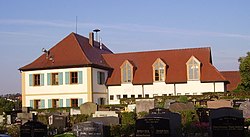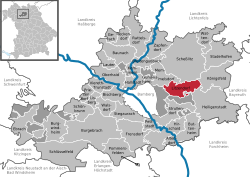Litzendorf | |
|---|---|
 Town hall | |
Location of Litzendorf within Bamberg district  | |
| Coordinates: 49°54′N11°0′E / 49.900°N 11.000°E | |
| Country | Germany |
| State | Bavaria |
| Admin. region | Oberfranken |
| District | Bamberg |
| Subdivisions | 8 Ortsteile |
| Government | |
| • Mayor (2020–26) | Wolfgang Möhrlein [1] (CSU) |
| Area | |
• Total | 25.85 km2 (9.98 sq mi) |
| Elevation | 311 m (1,020 ft) |
| Population (2024-12-31) [2] | |
• Total | 6,274 |
| • Density | 240/km2 (630/sq mi) |
| Time zone | UTC+01:00 (CET) |
| • Summer (DST) | UTC+02:00 (CEST) |
| Postal codes | 96123 |
| Dialling codes | 09505 |
| Vehicle registration | BA |
| Website | www.litzendorf.de |
Litzendorf is a municipality in the Upper Franconian district of Bamberg. Owing to administrative reform it has been a unified community since 1 May 1978.
Contents
- Geography
- Constituent communities
- Neighbouring communities
- History
- Population development
- Politics
- Municipal council
- Coat of arms
- Sightseeing
- Fränkische Straße der Skulpturen
- Singers’ memorial near Melkendorf
- Jungfernhöhle near Tiefenellern
- Barrows near Litzendorf
- Parish church of St. Wenceslas
- Gallery
- References
- External links


























